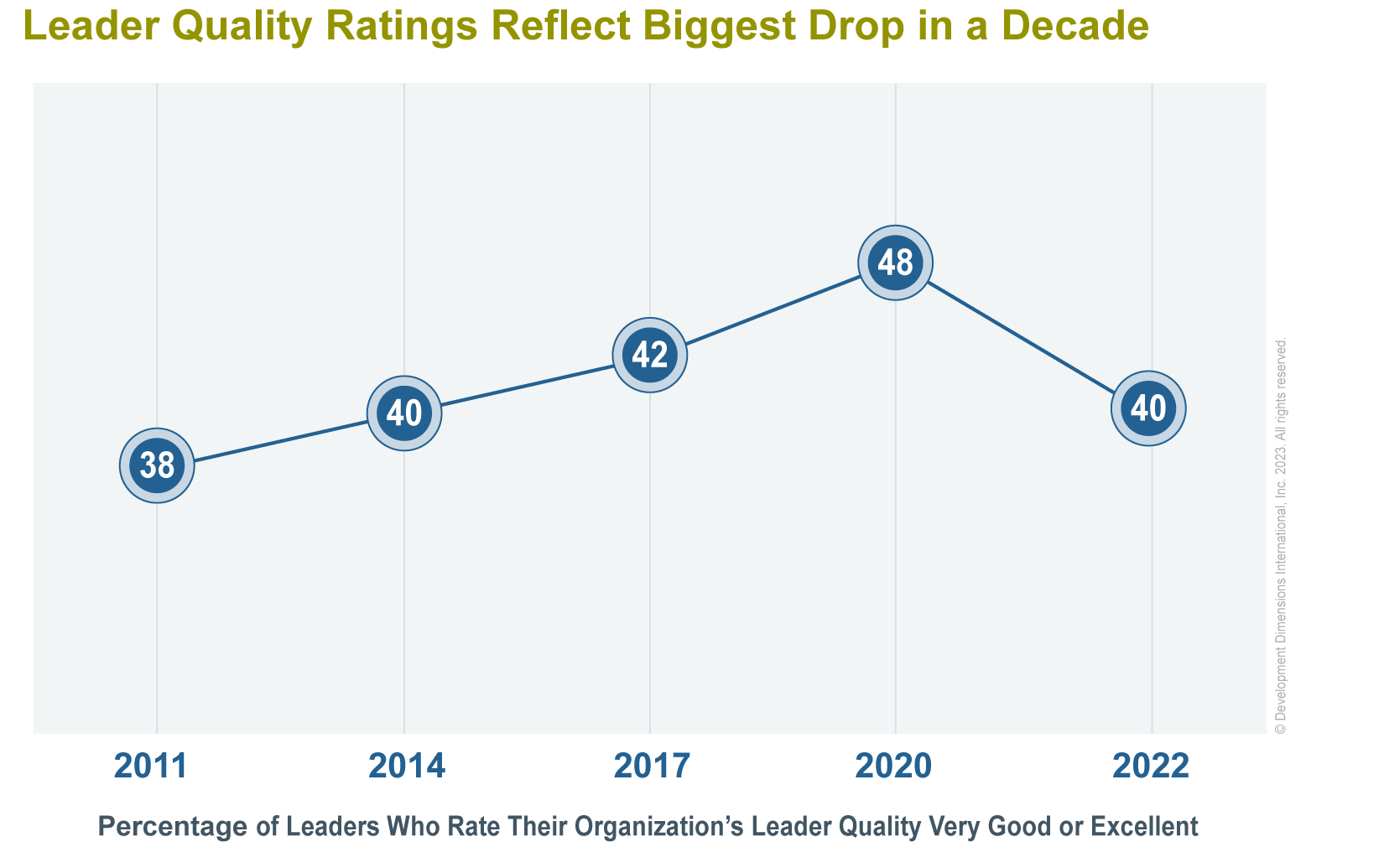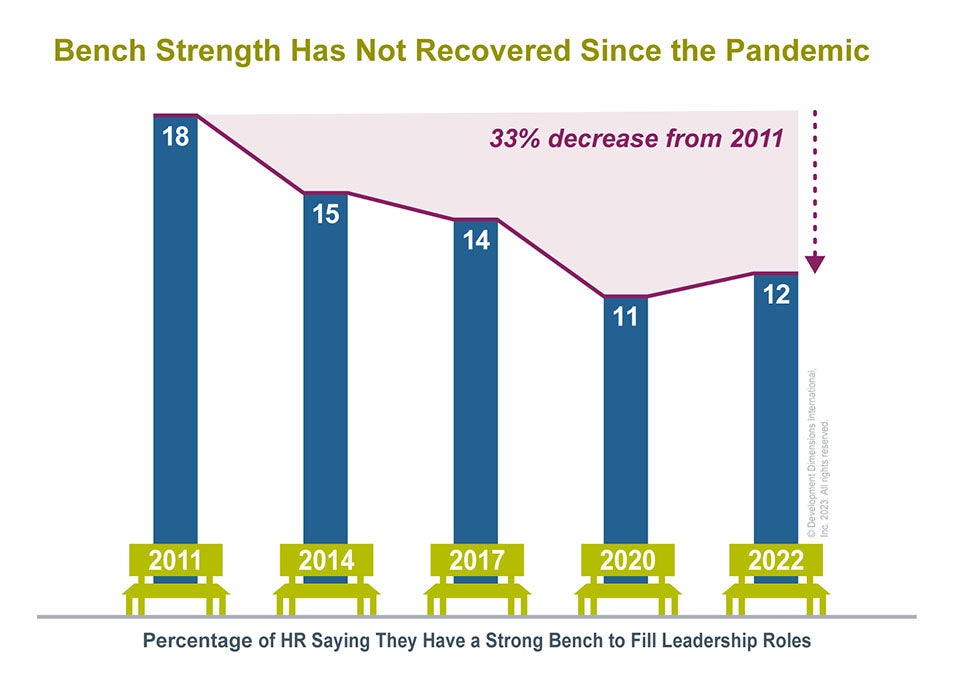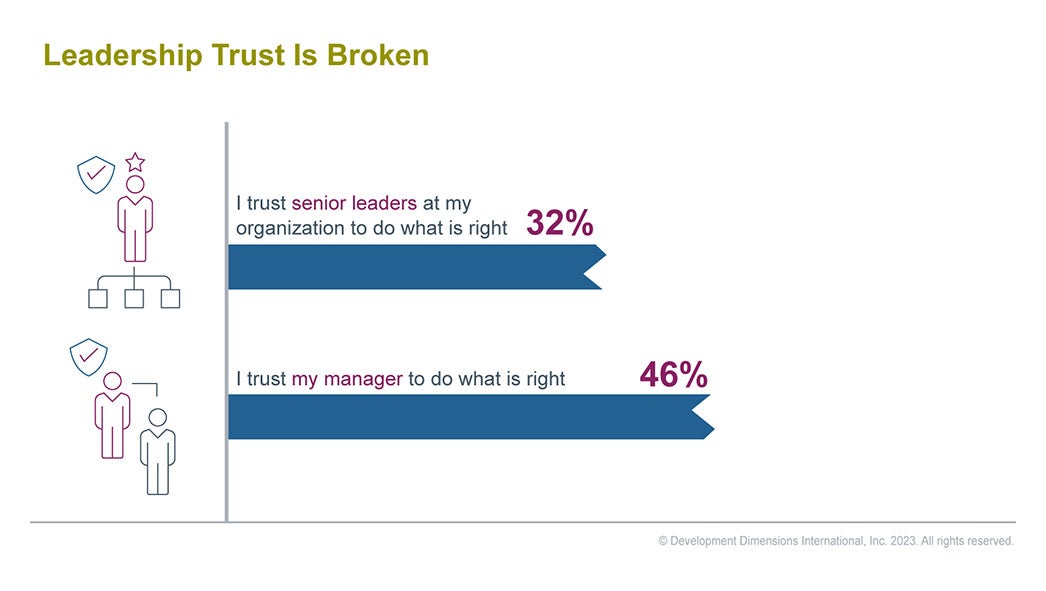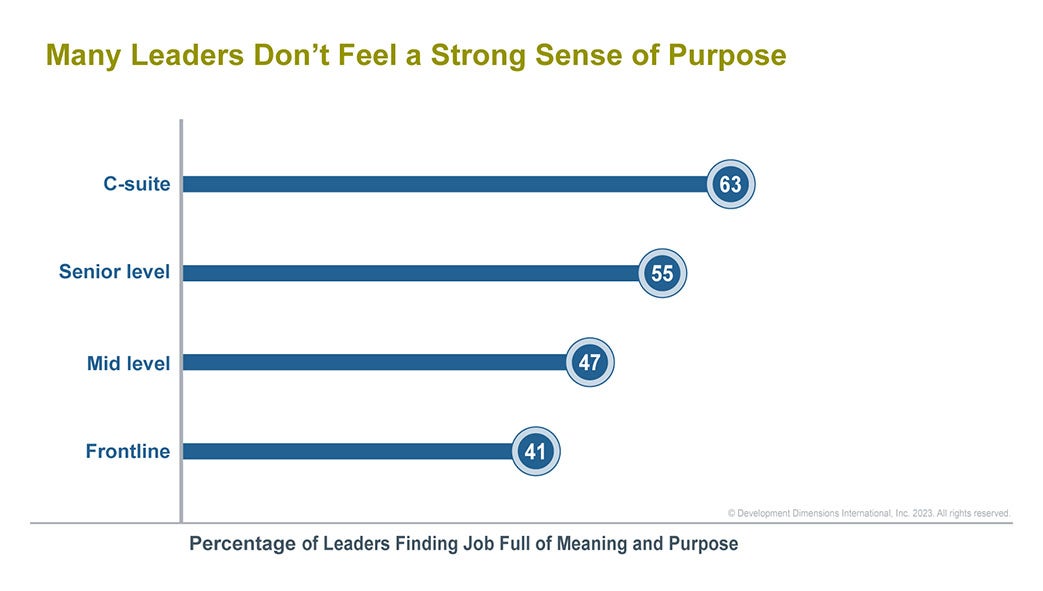For more than 20 years, we’ve been publishing the Global Leadership Forecast. And for the first time in over a decade of studying and measuring leadership quality, we saw a sharp drop in leaders’ ratings of the quality of leaders they work with—a sign that CEO priorities in 2023 must shift.

Only 40% of leaders say that their company has high-quality leaders overall, a nearly 20% drop from just two years ago. That puts current leadership quality ratings nearly on par with those in the wake of the 2007-2008 economic crisis.
This drop reflects leaders’ concerns about slowing growth and declining confidence that their companies will be successful in light of the challenges they are facing. And senior executives recognize this negative trend could cripple their workforce.
Amidst all the challenges that they are facing, CEOs are aware that their greatest risk is not having the talent needed to achieve their goals and meet the challenges ahead. Rising to the top of the list of CEO concerns, retaining talent was the #1 concern identified by 59% of CEOs this year.
CEOs are aware that retaining talent is a critical priority to ensure that their companies are equipped to compete in a rapidly changing business landscape. Failure to do so could result in a lack of people needed to lead and execute their priorities, which can put a company at further risk amidst a potential economic downturn.
This also means that, for the first time in more than 20 years of publishing our Global Leadership Forecast, CEOs and CHROs are in agreement on what the most critical business challenge for the next three years is: Retaining top talent.

According to this year’s Global Leadership Forecast survey, 54% of companies saw their turnover rate increase in the last year. This has made retention an acute challenge that CEOs and CHROs recognize they must confront to fuel their success against all other challenges.
It may be a uniquely challenging time for any leader, but our data show that there are three ways for leaders to regain the confidence of their employees and drive the retention they need.
1. Strengthening the Leadership Pipeline
Companies that prioritize developing a strong pipeline of leaders to fill critical roles have a greater chance of staving off the increasing risk of turnover and drive top talent retention.
One of the most concerning longitudinal trends over the past decade of Global Leadership Forecast research has been the shortage of leaders to fill critical roles. This year, only 12% of organizations said they have a strong bench to fill critical leadership roles.

This is an area being met head on by top-performing companies. When businesses strive to have adequate bench strength, they see more success where others struggle. Specifically, we found that companies with strong benches are 6X more likely to be capable of engaging and retaining top talent, 5X more capable of preventing employee burnout, and 3X more likely to be among top financial performing organizations in their industry compared to those with weak benches.
HR executives in these companies are actively preparing their leaders to think of the talent needs of tomorrow and offering high-potential leaders the opportunities to develop and grow their careers. As a result, leaders at these companies were much more confident in their leadership quality. Leaders rated their company’s overall leadership quality 10X higher in companies with strong benches compared to their peers.
2. Building a Culture of Trust
One of the driving factors behind leaders’ declining confidence in their companies’ leadership is a decline in trust. In this year’s Global Leadership Forecast, we heard that leaders, especially at the senior level, are struggling to build and maintain trust with their teams.

Only 46% of leaders report that they definitely trust their direct manager to do what is right. More troubling, only 32% say they trust senior leaders at their organization. This matches Edelman’s latest trust index findings which show that trust in leaders has plummeted, although trust in business leaders still exceeds that of other institutions.
This lack of trust is not only a risk to confidence, but also a risk in hampering productivity, growth, and innovation. When leaders don’t build trust, their employees are less likely to be productive and bring forward their best ideas at work.
CEOs and senior leaders will need to do more to build trust and earn back the confidence of their employees. Doing so will also help them retain the talent they are working so hard to attract and develop.
3. Help Leaders to Lead with Purpose
Despite companies’ best efforts to amplify purpose in their organization, fewer than half of mid-level leaders and front-line leaders are finding purpose at work. Even in the C-suite, fewer than two-thirds find their job full of meaning and purpose. This not only drives disengagement at virtually every level, but it also discourages high-potential individuals from stepping up into leadership roles.

When leaders feel a strong sense of purpose, they are 9X more likely to feel engaged in their role and 2.4X more likely to plan to stay at their companies than their peers who do not feel the same strength of purpose.
Plus, when leaders understand their career path, they are 4X more likely to find their jobs full of meaning and purpose than those who do not. By implementing effective talent strategies to build trust and purpose, leaders can help meet the expectations of their employees, build a strong and committed workforce, and ultimately achieve their business goals.
Success Depends on Good Leadership
Worryingly, fewer and fewer people want to step up into leadership roles. It’s critical that CEOs and talent leaders work towards building a company culture that equips leaders to bring their best work forward and, ultimately, succeed in the process.
Explore more of DDI's most recent research on leadership.
Stephanie Neal is director of the Center for Analytics and Behavioral Research (CABER). She leads market and trend research focused on leadership and business innovation and is the general manager and lead author of DDI's Global Leadership Forecast.
Topics covered in this blog

